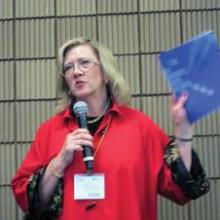NEW ORLEANS – New palliative care guidelines encourage discipline-specific certification for each of the major disciplines in a palliative care program, even for chaplaincy.
The guidelines are critical in raising the bar to guide the training of professionals and the development of programs, said Dr. Diane Meier, coleader of the National Consensus Project for Quality Palliative Care (NCP), which released the guidelines during the annual meeting of the American Academy of Hospice and Palliative Medicine.
Since the guidelines’ last revision in 2009, the Accreditation Council for Graduate Medical Education recognized hospice and palliative medicine as a subspecialty of 11 different parent boards. That paved the way for the development of hospice and palliative medicine fellowships, now an eligibility requirement for the board certification exams.
This year, the Centers for Medicare and Medicaid Services also began implementing an annual quality reporting program for hospice organizations that includes a financial incentive for hospice provider participation. Data from roughly 600 hospitals are also filed with the Center to Advance Palliative Care (CAPC), which releases a report card on access to palliative care in U.S. hospitals.
"Right now it’s too early in the field to use it for public reporting or payment, but it’s not too early to use it to be able to say, ‘Look, here are the standards, and here’s how we compare in terms of staffing ratios to peer hospitals in our part of the country, and we aren’t even close,’ " Dr. Meier, CAPC director and professor of geriatrics and palliative medicine at Mount Sinai Hospital in New York, said in an interview.
In 2011, 46% of the roughly 2.5 million deaths in the United States were under the care of one of the nation’s more than 5,000 hospices, with data suggesting that costs during the last year of life are cut by an average of $2,309 per hospice user.
The new, third edition of the Clinical Practice Guidelines for Quality Palliative Care, endorsed by some 50 organizations, emphasizes the need to deliver palliative care from the time of diagnosis, through an interdisciplinary team. Earlier editions of the guidelines were used as the basis for the National Quality Forum Framework and Preferred Practices for Quality Palliative Care, as well as the Joint Commission’s 2011 palliative care advanced certification.
Although hospice and palliative care at a 300-bed tertiary hospital will look substantially different than at a 40-bed community hospital, it must include all eight domains of care. It is not a physician and a half-time nurse doing pain consults, insists NCP coleader Betty Ferrell, Ph.D., R.N.
She observed that the social, cultural, and spiritual domains have undergone the biggest changes in the latest edition.
The social domain emphasizes the need to collaborate with patients and families to identify and capitalize on their strengths, and to use a social worker with patient population–specific skills in assessment and interventions. The cultural domain contains new content stressing the need for cultural and linguistic competence, including plain language, literacy, and delivering written materials in languages other than English. Translators also should be used for patients and families who do not speak or understand English, or for those who feel more comfortable communicating in another language.
"We really need to do a lot of this [work] because, if you look at our literature, you could say it’s kind of uni-perspective," Dr. Ferrell, a professor and research scientist at the City of Hope Medical Center in Los Angeles, acknowledged.
The spiritual domain was revised to include a definition of spirituality stressing assessment, access, and staff collaboration in attending to the spiritual, religious, and existential concerns throughout the illness trajectory.
"Chaplains may see a small minority of patients in the hospital; thus it’s important for all health care providers to address spiritual needs," she said.
The ethical and legal domain was reorganized into three sections to highlight the need for ongoing discussions about goals of care as well as greater communication and documentation of advance-care planning documents. The section also describes team competencies in the identification and resolution of ethical issues, and acknowledges the frequency and complexity of legal and regulatory issues in palliative care.
During a discussion of the guidelines, audience members said they’ve often been kept from doing the next step in care because of fear of legal reprisal. Only a dozen or so of the roughly 200 members in the audience, however, raised their hands when asked whether legal counsel had ever attended a palliative care meeting at their hospital.



